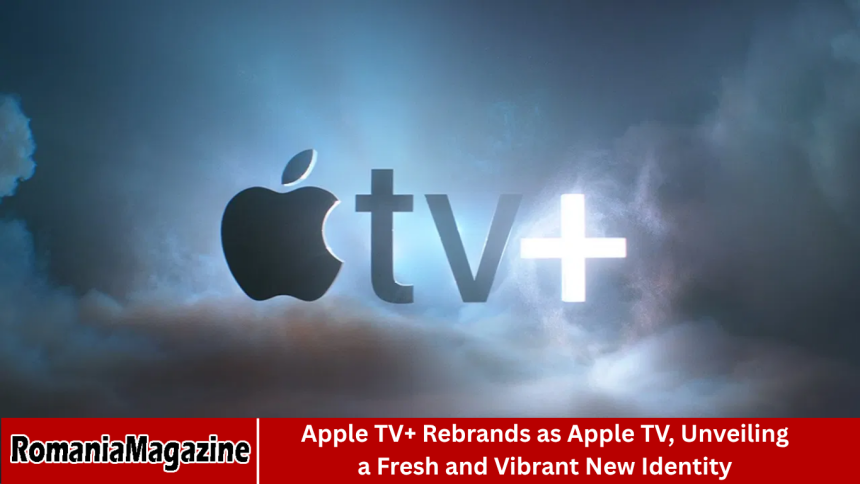In a move that’s making waves across the entertainment industry, Apple has officially announced that Apple TV+ will now simply be known as Apple TV. The rebranding marks a major shift in the company’s streaming identity — one that aims to simplify the brand, strengthen consumer recognition.
- From Apple TV+ to Apple TV: The Evolution of a Brand
- The Design Philosophy: Vibrant, Minimal, and Modern
- Strategic Motivation Behind the Rebrand
- Industry Reactions: Excitement and Curiosity
- Content and Future Roadmap: What’s Next for Apple TV
- The Broader Impact on Apple’s Ecosystem
- Consumer Experience: What Viewers Can Expect
- The Marketing Campaign: “A New Era of Apple TV”
- Competitor Landscape: How Apple TV Stands Out
- Looking Ahead: The Future of Apple TV
- Frequently Asked Question
- Why did Apple drop the “+” from Apple TV+?
- Will my Apple TV+ subscription change because of the rebrand?
- How will this affect the Apple TV app and Apple TV 4K hardware?
- What’s new in the redesigned Apple TV interface?
- Does the rebrand come with new content or features?
- How does Apple TV compare to competitors like Netflix and Disney+?
- What does this rebrand mean for Apple’s future in entertainment?
- Conclusion
And reflect Apple’s evolving entertainment vision. With this change, the tech giant isn’t just dropping a plus sign — it’s signaling a broader transformation in how audiences engage with Apple’s ecosystem of media, content, and technology.
Since its debut in November 2019, Apple TV+ has quickly evolved from a newcomer in the streaming wars to a powerhouse platform boasting award-winning originals like Ted Lasso, The Morning Show, and Killers of the Flower Moon.
More Read: Gemini Overlay Introduces New ‘Summarize Page’ Shortcut in Chrome for Android
From Apple TV+ to Apple TV: The Evolution of a Brand
When Apple TV+ first launched, the “plus” sign carried a familiar tech-world meaning — representing a premium, expanded service. It was part of a trend that swept the streaming industry, with services like Disney+, ESPN+, and Paramount+ embracing the symbol to signify enhanced offerings.
However, as the streaming landscape has matured, the “plus” has become less distinctive, blending into a sea of similar-sounding brands. Apple’s rebranding to Apple TV reflects a desire to return to simplicity and reinforce brand clarity.
The move eliminates potential confusion between Apple TV+ (the streaming service) and Apple TV (the app and hardware product line). By consolidating under one name, Apple creates a more cohesive and recognizable ecosystem that aligns with its core philosophy — clean, unified, and intuitive design.
A company spokesperson described the rebrand as part of Apple’s “commitment to clarity and creativity,” explaining that the new identity “reflects the evolution of Apple’s storytelling and entertainment experience — simple, elegant, and universally accessible.”
The Design Philosophy: Vibrant, Minimal, and Modern
The new Apple TV identity introduces a visual overhaul characterized by bold, vibrant colors, fluid animations, and a refined logo design that mirrors Apple’s current design direction across macOS, iOS, and other platforms.
Gone is the sleek, reserved aesthetic of the “+” era — in its place is a more dynamic, approachable, and energetic look. According to Apple’s design team, the refreshed visual identity emphasizes “movement, light, and emotion,” aiming to evoke the cinematic experience that Apple’s content delivers.
The new wordmark uses a softer, rounded typeface, while the app interface now features more personalized curation, rich imagery, and immersive previews. This design shift also aligns with the company’s broader rebranding efforts across its ecosystem.
From Apple Music’s visual overhaul to the evolution of the App Store’s editorial content. Apple’s consistent design language ensures that users feel an immediate sense of familiarity and connection, no matter which service they’re using.
Strategic Motivation Behind the Rebrand
Apple’s decision to drop the “plus” is more than an aesthetic update — it’s a strategic realignment. The streaming industry has reached a point of saturation, with consumers juggling multiple subscriptions, each vying for attention.
In this crowded space, clarity and brand strength are more important than ever. By simplifying the name to Apple TV, Apple removes ambiguity about what the service represents. It also reflects the company’s effort to position Apple TV as a holistic entertainment hub.
Not just a subscription platform, but a centralized space for movies, series, live sports, and even third-party content. Analysts point out that this move follows a broader industry trend. Disney, for instance, has streamlined its branding across Disney+ and Hulu; Netflix has integrated games and live events into its ecosystem.
Apple’s rebranding signals its intent to go beyond streaming shows — it’s building a complete entertainment environment, integrated with Apple hardware, AI recommendations, and global accessibility.
Industry Reactions: Excitement and Curiosity
The announcement sparked widespread conversation across both the tech and entertainment communities. Many see Apple’s decision as a confident step — one that shows maturity and ambition in a market dominated by a few major players.
Marketing experts have praised the rebrand as “a masterclass in minimalism.” Others have highlighted its timing, noting that Apple’s streaming service has now reached a level of global recognition where it no longer needs the “+” to signify exclusivity or premium value.
However, some viewers expressed initial confusion, wondering whether Apple TV (the streaming service) will now be fully integrated with Apple TV (the app) or Apple TV 4K (the hardware). Apple has since clarified that while all these entities share the same name.
They remain distinct yet interconnected parts of a seamless ecosystem — accessible through one unified interface. Entertainment insiders also note that the rebrand could coincide with a new wave of high-profile content launches, including collaborations with major studios and global filmmakers.
Apple’s growing influence at film festivals and award shows underscores its evolving identity as not just a tech company, but a major player in the creative industry.
Content and Future Roadmap: What’s Next for Apple TV
The rebrand arrives at a pivotal moment when Apple is expanding its original programming portfolio and experimenting with new formats. Over the next year, Apple TV is expected to introduce a wider range of genres, including documentaries, unscripted series, global dramas.
And live sports — areas where competitors like Netflix and Amazon have made significant strides. Apple’s partnerships with creators such as Martin Scorsese, Ridley Scott, and Oprah Winfrey continue to define its reputation for quality over quantity.
With the rebrand, Apple plans to highlight its distinctive storytelling approach — emphasizing creativity, emotional depth, and cinematic excellence. Additionally, Apple’s rumored integration of AI-powered personalization into the Apple TV experience could transform how users discover and interact with content.
Imagine a system that intelligently curates shows based on not just what you watch, but how you watch — your emotional responses, time of day, and even device usage patterns.
Apple is also said to be exploring deeper ties between Apple TV and Apple Arcade, offering immersive storytelling experiences that blend video content with interactive elements. This aligns with Apple’s long-term goal: making entertainment not just something you watch, but something you experience.
The Broader Impact on Apple’s Ecosystem
Apple’s rebranding strategy is rarely isolated — every change is interconnected within its vast ecosystem. The transition from Apple TV+ to Apple TV complements updates across Apple’s software and hardware platforms.
- Apple One Integration: The rebrand reinforces Apple’s bundled service offering, where Apple TV sits alongside Music, Arcade, iCloud+, and Fitness+. The new name simplifies marketing and improves cross-service synergy.
- Hardware Alignment: Apple TV 4K, the company’s streaming device, will now feature an interface perfectly aligned with the rebranded service, providing a unified visual and functional experience.
- AI and Siri Enhancement: The new Apple TV experience may feature enhanced voice search and smart recommendations via Siri, powered by Apple Intelligence — the company’s next-generation AI initiative.
- Cross-Platform Expansion: Apple continues to make its service more widely available on smart TVs, gaming consoles, and non-Apple devices, expanding its footprint far beyond its own ecosystem.
In essence, the new identity signals that Apple TV is no longer just a streaming app — it’s the heart of Apple’s entertainment world.
Consumer Experience: What Viewers Can Expect
For the average user, the transition will feel seamless yet refreshingly new. Existing subscribers won’t need to take any action — their accounts, subscriptions, and watchlists will carry over automatically. What they will notice is a redesigned interface, richer curation, and smoother navigation.
Apple promises a “vibrant, cinematic experience” that celebrates storytelling. New onboarding features guide users through personalized recommendations, while adaptive layouts highlight trending content, new releases, and exclusive Apple Originals.
Users will also benefit from tighter integration between the Apple TV app and the Apple ecosystem — including continuity across iPhone, iPad, and Mac. Watch progress syncs instantly between devices, while shareable playlists and “watch together” modes make social viewing easier than ever.
Moreover, Apple is doubling down on accessibility and inclusivity, offering expanded language options, descriptive audio, and improved captioning tools — part of the company’s broader commitment to making entertainment universally enjoyable.
The Marketing Campaign: “A New Era of Apple TV”
To mark the rebrand, Apple is rolling out a global campaign titled “A New Era of Apple TV.” The campaign features sleek visuals, colorful motion graphics, and an energetic soundtrack celebrating creativity and connection through storytelling.
Apple’s promotional materials highlight iconic moments from its original shows — from Severance’s surreal aesthetic to Ted Lasso’s heartfelt optimism — showcasing the emotional range that defines Apple’s content library.
The campaign tagline, “All Stories. One Apple TV.”, encapsulates the brand’s vision for unification and simplicity. In typical Apple fashion, the rollout is meticulously timed, with synchronized app updates, press coverage, and teaser trailers.
Retail stores and product packaging will also reflect the new branding, creating a consistent presence across all customer touchpoints.
Competitor Landscape: How Apple TV Stands Out
With giants like Netflix, Disney+, and Amazon Prime Video dominating the market, Apple’s rebrand is as much a strategic positioning move as it is a marketing refresh. While competitors often prioritize vast content libraries, Apple continues to distinguish itself through curation, quality, and prestige.
Apple TV’s focus on premium storytelling — combined with its tight integration into the Apple ecosystem — gives it a unique advantage. Unlike other platforms, Apple doesn’t rely heavily on advertising or volume-based content strategies.
Instead, it cultivates a boutique brand image — where every series feels cinematic, every story purposeful. The rebrand further solidifies this positioning, emphasizing a singular, premium entertainment experience rather than a fragmented service.
Looking Ahead: The Future of Apple TV
The rebrand of Apple TV+ to Apple TV is more than a cosmetic update — it’s a declaration of intent. Apple is signaling that its entertainment ambitions are expanding. The company envisions Apple TV as the ultimate hub for storytelling, seamlessly blending technology, creativity, and emotion.
As the service enters its next chapter, expect continued investment in global productions, deeper AI integration, and collaborations with some of the world’s most visionary creators.
Apple’s signature combination of artistry and innovation ensures that the “vibrant new identity” is just the beginning of an exciting evolution. In many ways, Apple’s rebrand encapsulates its timeless philosophy: simplicity is the ultimate sophistication.
Frequently Asked Question
Why did Apple drop the “+” from Apple TV+?
Apple dropped the “plus” to simplify its brand and unify its entertainment identity. The “+” once represented premium content, but with the brand’s growing global recognition, Apple wanted a cleaner, more cohesive name that reflects both its service and ecosystem.
Will my Apple TV+ subscription change because of the rebrand?
No. Existing subscribers will retain their accounts, subscriptions, and watch history. The change is purely cosmetic and organizational — enhancing design, branding, and user experience without affecting pricing or availability.
How will this affect the Apple TV app and Apple TV 4K hardware?
Both will now align under the single Apple TV branding. While they remain distinct products, they’ll share consistent visuals, navigation, and user experiences to create a seamless entertainment environment.
What’s new in the redesigned Apple TV interface?
The new Apple TV interface introduces vibrant visuals, improved navigation, personalized recommendations powered by AI, and more dynamic content previews — all designed to enhance discoverability and engagement.
Does the rebrand come with new content or features?
Yes. Apple is expanding its library with new original shows, global content, and possibly live sports programming. The company is also enhancing accessibility, personalization, and cross-device continuity.
How does Apple TV compare to competitors like Netflix and Disney+?
While Netflix and Disney+ emphasize large content catalogs, Apple TV focuses on quality over quantity — offering high-production, story-driven originals. The new branding reinforces Apple’s premium, cinematic identity.
What does this rebrand mean for Apple’s future in entertainment?
The rebrand signals Apple’s long-term commitment to being a major player in entertainment. It sets the stage for innovation in AI-driven content discovery, creative collaborations, and cross-platform storytelling experiences.
Conclusion
Apple’s transformation from Apple TV+ to Apple TV is more than a name change — it’s a statement of evolution. The vibrant new identity captures the company’s confidence in its creative vision, technological strength, and cultural influence.
By simplifying its brand and amplifying its storytelling, Apple has positioned Apple TV as not just another streaming service, but a cornerstone of modern digital entertainment. With bold design, seamless integration, and a clear focus on quality storytelling.









